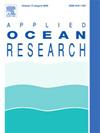Short-duration design waves for modelling of extreme second-order surge response with spar substructure test case
Abstract
This work aims to determine the wave conditions that generate maximum surge response excited predominantly by second-order difference frequency forces. Standard narrow-band wave conditions have random phase components and obtaining the maximum surge response requires long sea-state durations to cover all combinations and correspondingly long computation times using second-order diffraction–radiation models. Multiple 3-hour random sea-states are typically used to evaluate the expected extreme response. The maximum force may be obtained by shifting phases to be equal between component pairs with a frequency difference equal to the structure’s surge natural frequency. However, this work shows that such an approach gives a highly transient force and the lightly damped surge displacement response does not approach a representative maximum value. The larger motion responses may be achieved by sequential wave groups and here we use a genetic algorithm to optimise the phase distribution to give more regular low-frequency excitation in relatively short sea-state durations, less than 1 h. This is demonstrated with a one degree-of-freedom Fourier model. The method is applied to a lightly-moored spar substructure and compared with an experimentally validated standard six degree-of-freedom time domain model (Orcaflex) showing satisfactory agreement.

 求助内容:
求助内容: 应助结果提醒方式:
应助结果提醒方式:


